In today’s digital-first world, your school’s website is no longer just a brochure — it’s your frontline marketing tool.
When parents, students, or even local communities look for schools online, they don’t start by walking through your gates. They start with Google.
That’s where SEO comes in — and unfortunately, that’s also where many schools get it wrong.
Whether it’s a slow-loading website, poor mobile design, or simply not showing up on maps, these SEO errors silently hurt your school’s visibility, trust, and even admissions.
And here’s the kicker: most school admins don’t even know these mistakes exist — until it’s too late.
In this article, we’re not just pointing fingers. We’ll walk you through the 10 most common SEO Mistakes for Schools, show you how to fix them step-by-step,
and share real strategies you can start applying immediately — even without a technical background.
This isn’t theory. This is digital marketing tailored for schools that want to grow.
Let’s start with why SEO is more critical in 2025 than ever before.
This article covers what not to do — but for a step-by-step plan to actually grow your visibility, check out our SEO guide for schools in 2025
Why SEO Matters for Schools in 2025
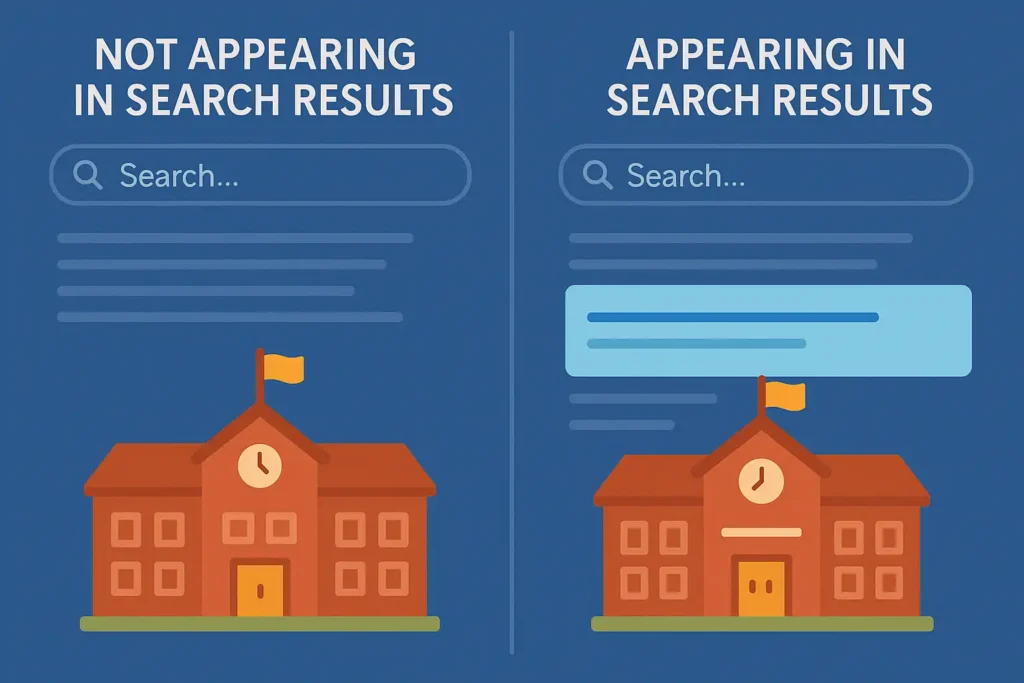
In 2025, if your school isn’t showing up on the first page of Google — you’re invisible.
Today’s parents and students don’t wait for brochures or referrals. They Google it, compare options, check reviews, and make quick decisions based on what they find online — not offline.
Let’s look at a few real trends shaping this shift:
1. Parents Now Research Like Consumers
Before contacting a school, parents:
- Search “best schools near me”
- Check Google reviews
- Compare website content and facilities online
- Look for proof: awards, activities, and results
If your school’s site is outdated or doesn’t rank — they’ll never even consider you.
2. Google Is the New School Directory
Forget newspapers or banners. In most cities and towns, parents now search:
- “CBSE schools in [city]”
- “Top 10 schools near [area]”
- “Best English medium school in [district]”
If your school doesn’t appear in those local searches, it’s missing 70–80% of its discovery traffic.
3. Mobile & Voice Search Are Exploding
More than 60% of education-related searches happen on mobile devices. And with smart assistants like Alexa and Google Assistant, even voice search is rising.
But here’s the catch:
Google only picks websites that are mobile-friendly, fast, and SEO-optimized for local and long-tail queries.
If your school’s site isn’t built for that — you lose, even if your facilities are world-class.
4. SEO = Long-Term Admissions Growth
While paid ads give a short-term push, SEO:
- Builds long-term visibility
- Brings in consistent organic traffic
- Reduces reliance on big ad budgets
- Increases trust (top-ranking schools are seen as more credible)
Think of SEO like planting trees. It takes time, but it pays you back every year without needing more money.
Final Thought Before We Dive In
Most schools spend lakhs on infrastructure and advertising — but barely touch their digital foundation.
If you fix your SEO now, you’ll be ahead of 90% of schools still stuck in 2015 tactics.
Ready to find out what mistakes your school might be making?
Let’s break down the top 10.
Most schools think a few pages and some photos are enough to “do SEO.” But in 2025, that mindset is a silent admissions killer.
🎯 If you want to actually show up in parent searches and convert traffic into real inquiries — don’t miss this:
👉 Explore the Proven Private School Marketing Playbook That Elite Schools Use to Stay Ahead »
Quick Overview – The 10 SEO Mistakes Schools Commonly Make
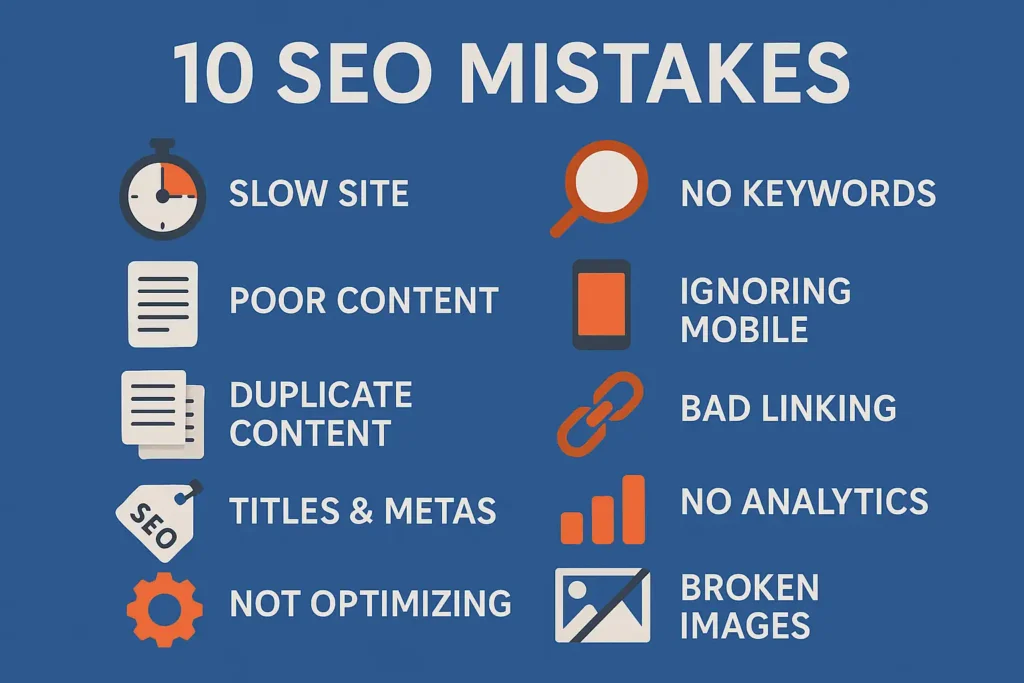
Before we explore each mistake in depth, here’s a quick glance at the most common SEO errors we see on school websites across India (and beyond):
You might recognize a few of these already — but don’t worry, we’ll show you exactly how to fix each one.
The 10 Most Common SEO Mistakes for Schools
- No Google Business Profile Setup
→ Your school isn’t visible on local searches or maps. - Ignoring Mobile Optimization
→ Most parents search on phones, but your site isn’t mobile-friendly. - Slow-Loading Website
→ Visitors bounce before they even see your homepage. - No Keyword Strategy
→ Your content doesn’t match what people are searching for. - Missing Local SEO Optimization
→ You’re not ranking for “schools near me” or city-based searches. - Lack of Quality Content (No Blog or Updates)
→ No fresh content = No traffic. - Weak On-Page SEO (Titles, Meta, Headings)
→ Your site confuses search engines — and users. - Not Tracking SEO Performance (No Analytics)
→ You’re flying blind without data. - No Backlinks or Local Listings
→ Google doesn’t see your school as trustworthy. - Poor User Experience and Site Structure
→ Confusing menus, broken links, and no clear CTA = lost admissions.
Each of these mistakes may seem small — but combined, they can seriously damage your online visibility and reputation.
In the next section, we’ll break down each mistake one by one and show you how to fix it like a pro, even if you’re not a technical expert.
Once your website structure is optimized, it’s time to attract attention locally. Don’t miss our actionable guide on how schools can boost local SEO before admissions start
SEO Mistake #1 – No Google Business Profile Setup
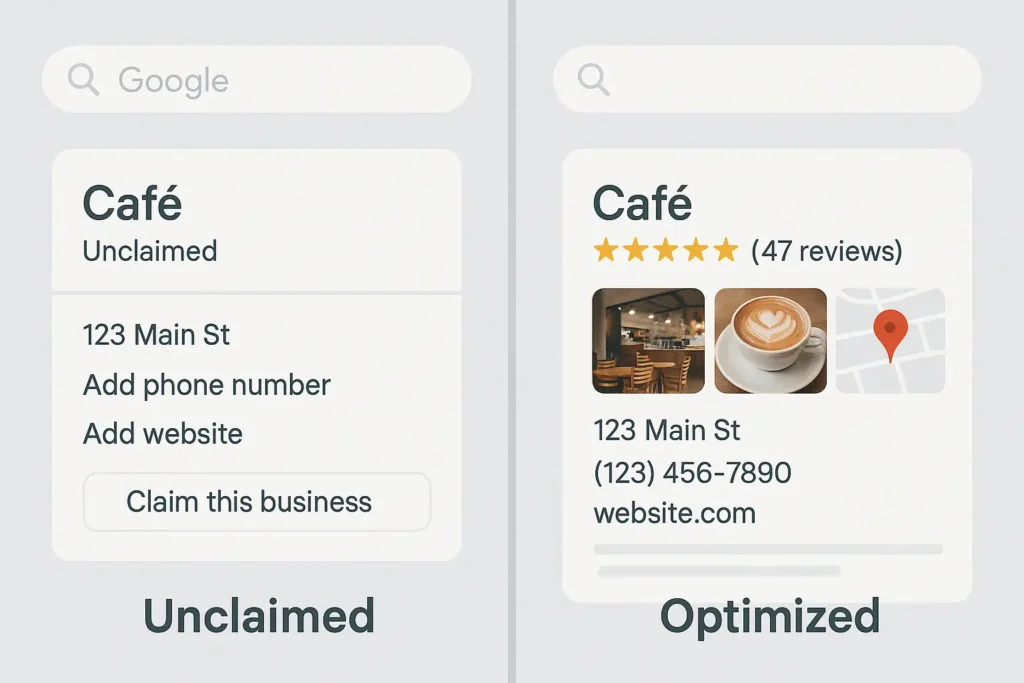
Let’s be honest — when was the last time someone found your school through a newspaper ad?
In 2025, when parents search “best school near me” or “CBSE school in [city]”, the first thing they see isn’t your website — it’s your Google Business Profile (formerly Google My Business).
Yet, hundreds of schools either don’t have one, haven’t claimed it, or have outdated info. That’s like having a school building but no signboard outside.
Why It Hurts Your School’s SEO
A missing or poorly maintained Google Business Profile means:
- Your school won’t appear in local search results (even if you’re nearby)
- You won’t show up on Google Maps, which parents heavily rely on
- You miss the chance to display reviews, photos, contact info, and directions
- You lose trust — people assume you’re outdated or inactive
Google uses this profile as a trust and relevance signal. No profile = no visibility.
How to Fix It – Step-by-Step
Here’s how to set up and optimize your school’s Google Business Profile the right way:
- Claim Your Profile
- Go to google.com/business
- Search for your school. If it exists, claim it. If not, create a new listing.
- Add Accurate Basic Info
- School name, address, phone, website, hours of operation
- Make sure it matches your website and social media exactly (NAP consistency)
- Select the Right Categories
- Example: “CBSE School,” “Private School,” “Educational Institution”
- Avoid vague or incorrect tags like “Education Center” unless relevant
- Upload High-Quality Photos
- Front gate, classrooms, playground, events — give parents a virtual walk-through
- Enable Reviews and Start Asking
- Encourage happy parents and alumni to leave reviews
- Reply to each review — even the negative ones, professionally
- Post Updates Weekly
- Events, admission alerts, achievements — keep it fresh
- Google rewards active profiles with better visibility
Pro Tip from a Digital Marketing Agency
Schools that optimize their Google Business Profile see up to 3x more local traffic and phone calls — without spending a single rupee on ads.
It’s one of the easiest, free, and high-impact steps you can take to boost your school’s online presence.
SEO Mistake #2 – Ignoring Mobile Optimization
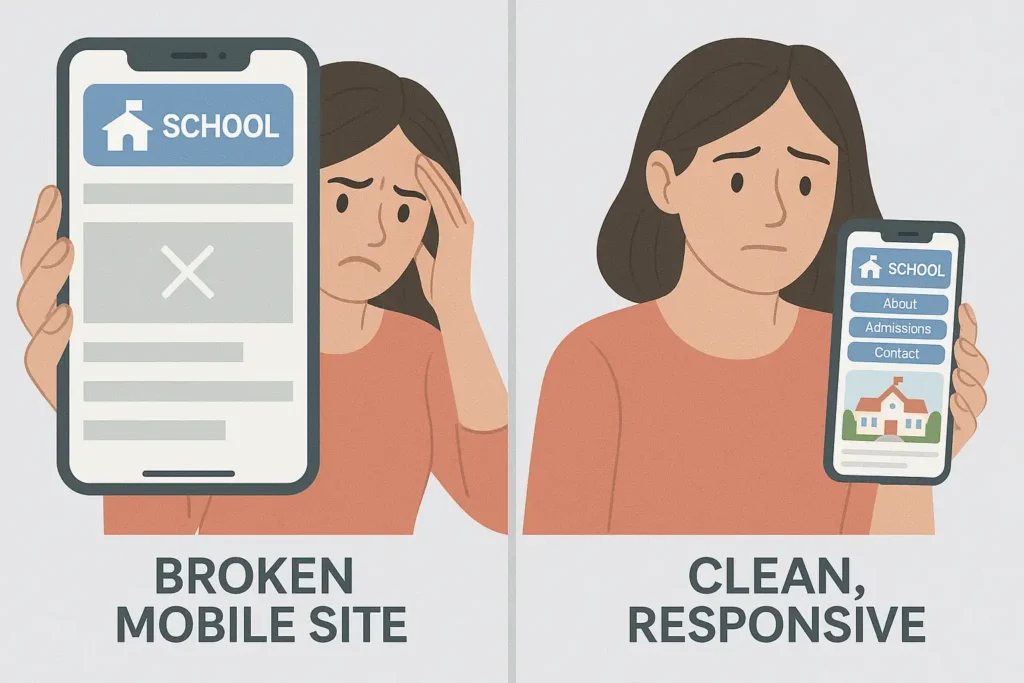
If your school’s website isn’t mobile-friendly in 2025, you’re not just behind — you’re invisible.
Over 60% of school-related searches happen on smartphones. Parents don’t wait to reach home to check your website. They search during lunch breaks, in the car, or while scrolling late at night.
If your site looks broken, takes forever to load, or is hard to navigate on mobile, they won’t give it a second chance.
Why This Kills Your SEO
Google uses mobile-first indexing, meaning it judges your website based on how it performs on a phone — not a desktop.
A non-optimized mobile site leads to:
- Lower rankings in Google search
- High bounce rates (visitors leave immediately)
- Frustrated parents who don’t bother exploring further
- A bad impression that makes your school seem outdated or careless
Even if your content is excellent, poor mobile experience can destroy your visibility and credibility.
How to Fix It – Step-by-Step
Improving mobile optimization isn’t just about shrinking your site — it’s about building for speed, clarity, and touch-first use.
- Use a Mobile-Responsive Theme
- Platforms like WordPress + Astra or Hello Elementor are mobile-friendly by default
- Avoid bulky themes or templates with too many animations
- Test Your Site on Mobile
- Use Google’s Mobile-Friendly Test
- Or test it yourself on multiple devices (scroll, click, zoom, navigate)
- Fix Layout & Navigation
- Use large buttons, clear menus, and readable fonts
- Avoid horizontal scrolling or too many popups
- Optimize Speed for Mobile
- Compress images (use WebP format)
- Minimize CSS & JS (use LiteSpeed Cache plugin if on WordPress)
- Use lazy loading for media files
- Make Forms Simple
- Keep admission/contact forms short
- Use autofill, dropdowns, and clear call-to-action buttons
Pro Tip from a Marketing Strategist
The average parent decides whether to stay on your site within 3 seconds on mobile.
If your homepage or contact form doesn’t load instantly — you’ve already lost them.
Make mobile experience a priority, not an afterthought. It’s where trust is won or lost.
SEO Mistake #3 – Slow-Loading Website
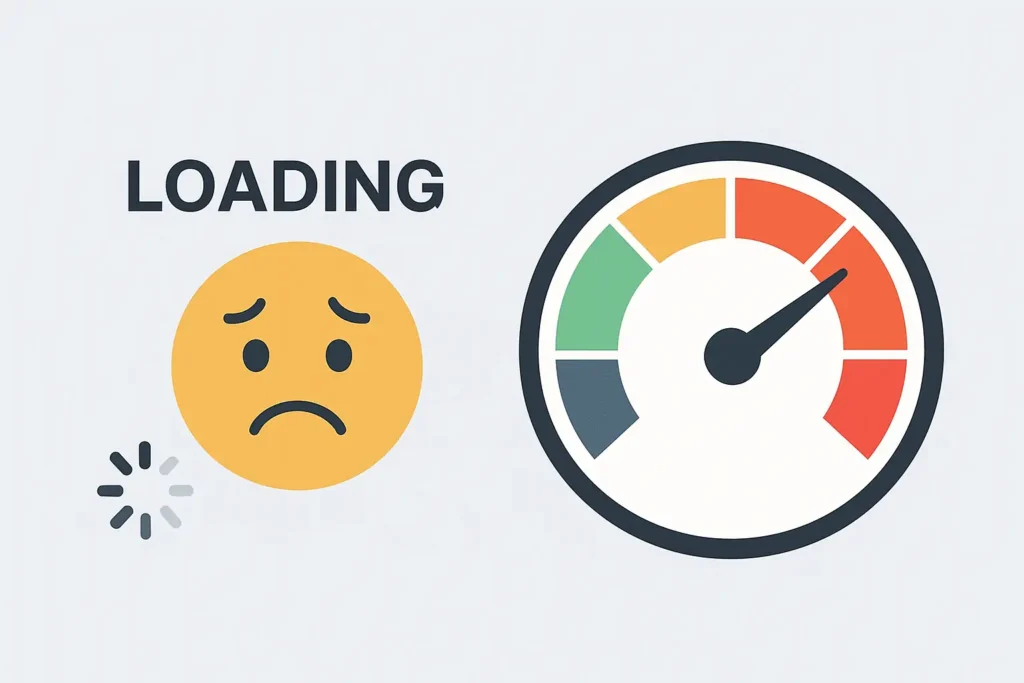
Think of your website like the school gate. If it takes forever to open, no one wants to enter.
In 2025, speed is no longer a luxury — it’s a ranking factor, a user expectation, and a conversion driver. Unfortunately, most school websites are built with outdated themes, bulky designs, or overloaded image galleries — and that costs them rankings and trust.
Why Site Speed Matters for SEO
Google has made it official: site speed directly affects search rankings, especially on mobile.
Here’s what a slow website does to your school:
- Causes visitors to bounce before even reading anything
- Kills mobile experience (especially in low-network areas)
- Hurts your Google Core Web Vitals score
- Makes you look outdated and unprofessional
- Reduces your chance to appear in top results or featured snippets
Even half a second delay can cause 20-30% drop in engagement. That’s a lot of lost admissions.
How to Fix It – Step-by-Step
Speed optimization isn’t just for tech geeks. Here’s how you can make your school website faster without hiring a developer:
- Use a Lightweight Theme
- Astra + Elementor (Free) is a fast, clean combo for WordPress
- Avoid overly flashy templates that slow down loading
- Compress and Optimize Images
- Use free tools like TinyPNG or ShortPixel
- Convert all images to WebP format
- Keep homepage images under 200KB
- Use a Speed Plugin
- If you’re using WordPress + LiteSpeed Server: Install LiteSpeed Cache
- Turn on features like:
- Minify CSS/JS
- Lazy Load Images
- Browser Caching
- Host on a Fast Server
- Avoid cheap hosting that can’t handle speed
- Use providers like Hostinger (if optimized), Cloudways, or any with LiteSpeed stack
- Test with Google PageSpeed & GTmetrix
- Aim for a score above 85 and Total Blocking Time (TBT) < 200ms
Pro Tip from a Technical SEO Analyst
Most schools obsess over design and animations — but what really builds trust is how fast the site loads when a parent taps the link.
Fast sites get more engagement, better rankings, and higher inquiries.
Not sure if your school’s website is crawlable or technically optimized?
👉 Run This Step-by-Step Technical SEO Audit →
SEO Mistake #4 – No Keyword Strategy

Here’s a hard truth:
Most school websites are built beautifully — but are invisible on Google. Why?
Because they don’t align their content with what parents are actually searching for.
This is what we call a keyword strategy — and if your school doesn’t have one, you’re basically writing in a language Google doesn’t understand.
Why This Hurts Your School’s SEO
Google ranks pages based on relevance.
If your site doesn’t include the words people are searching for — like “best school in [city]” or “CBSE school near me” — you’ll never appear in search results, even if your site looks great.
Without a keyword strategy, your website:
- Fails to show up for relevant local searches
- Gets low-quality traffic (or none at all)
- Misses opportunities to target long-tail, low-competition queries
- Can’t scale your SEO efforts over time
In short: you’re publishing blind.
How to Fix It – Step-by-Step
You don’t need an agency or expensive tools to build a smart keyword plan. Here’s how:
- Identify What Parents Are Searching
- Use tools like Ubersuggest, AnswerThePublic, or even Google Auto Suggest
- Example searches:
- “CBSE school in Patna with hostel”
- “affordable English medium school near me”
- “top 10 schools in [your area]”
- Make a Keyword List (Seed + Long-Tail)
- Group them into categories:
- Homepage → “best school in [city]”
- Blog → “how to choose a school for your child”
- About Page → “CBSE school with sports in [city]”
- Group them into categories:
- Use Keywords Naturally in Key Areas
- Page Title
- Meta Description
- H1 and H2 Headings
- First 100 words of content
- Image alt text
- URL slug (example: /cbse-school-patna)
- Build One Page for One Intent
- Don’t try to rank one page for 10 topics
- Make focused content that directly answers one type of search query
- Track Performance
- Use free tools like Google Search Console to see what keywords your site is ranking for
- Optimize based on what’s working
Want to improve your homepage before the next admission season? Don’t miss our step-by-step guide: Web Design for Schools – 7 Must-Know Tips Before You Launch
Pro Tip from a Keyword Strategist
Never assume what parents are searching. Validate it with data.
SEO isn’t about guessing — it’s about aligning content with actual user intent.
Even a small school website with a smart keyword map can outrank larger institutions that don’t optimize at all.
SEO Mistake #5 – Missing Local SEO Optimization
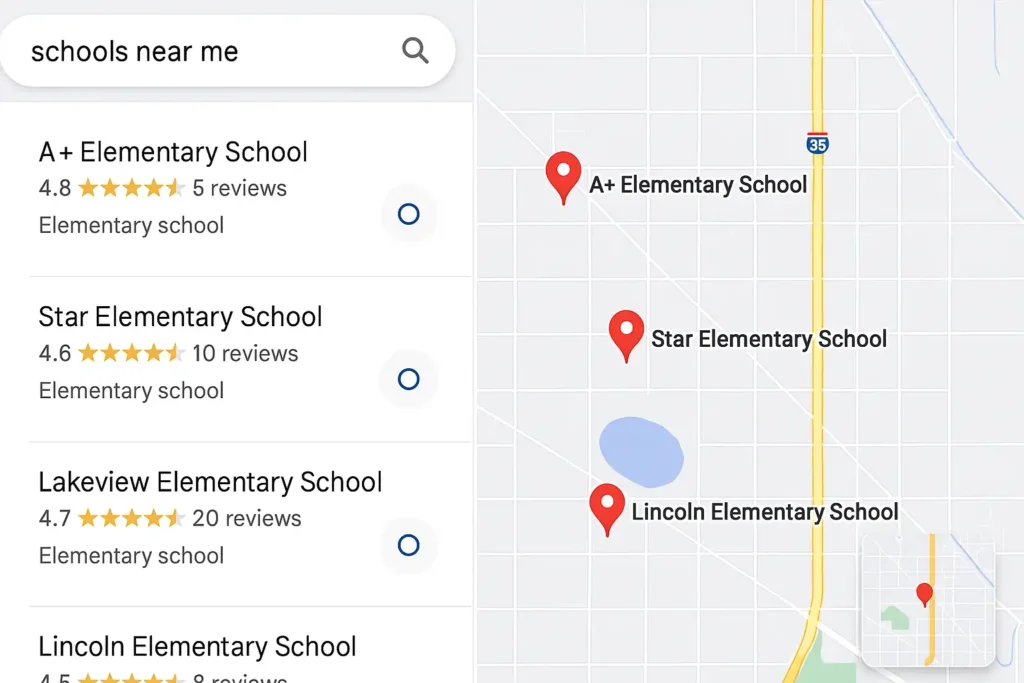
Imagine a parent in your area types:
“Best school near me”
“Top CBSE school in [your city]”
“ICSE school with hostel in [area]”
If your school doesn’t show up in the local search results, you’re losing out — not because your school isn’t good, but because Google doesn’t recognize your local relevance.
This is the core of Local SEO, and most schools completely ignore it.
Why Local SEO Is a Game-Changer for Schools
Google’s local algorithm is designed to show location-based results — especially on mobile.
Without proper local SEO:
- You won’t show up in “near me” searches
- Your website may rank nationally but not in your own city
- Competitors with weaker schools but better SEO will outrank you
Local SEO helps your school become discoverable in your neighborhood, where real admissions happen.
How to Fix It – Step-by-Step
You don’t need advanced tools or agencies to win at local SEO. Here’s how you can optimize smartly:
1. Target Location-Based Keywords
Use terms like:
- “CBSE school in Patna”
- “Top girls’ school in Delhi”
- “Best English medium school in [your area]”
Place these naturally in:
- Page titles
- H1 headings
- Homepage and contact page text
- Blog articles (“Why [your school] is the best in [location]”)
2. Create a Dedicated ‘Location Page’
If your school is in multiple areas or serves multiple localities:
- Create separate pages like /cbse-school-patna/, /cbse-school-bihta/
- Each page should be customized with local photos, directions, maps, etc.
3. Embed a Google Map on Your Contact Page
- Make it easy for visitors (and Google) to locate you
- Also adds trust and visual appeal
4. Get Listed in Local Directories
- Register on JustDial, Sulekha, YellowPages, Education-related forums
- Ensure NAP consistency: Name, Address, Phone number must be exactly the same everywhere
5. Collect Local Reviews on Google
- Encourage parents and students to leave reviews mentioning your school name + city
Example: “Great CBSE school in Patna with great teachers.”
6. Add ‘Near Me’ Signals in Content
- Blog ideas like:
- “Why We’re the Best School Near [Landmark/Colony Name]”
- “Top 5 Reasons Parents in [Area] Choose Our School”
Pro Tip from a Local SEO Strategist
Local SEO isn’t just about rankings — it’s about owning your location digitally.
The more Google trusts your local presence, the more parents will too.
SEO Mistake #6 – Lack of Quality Content (No Blog or Updates)
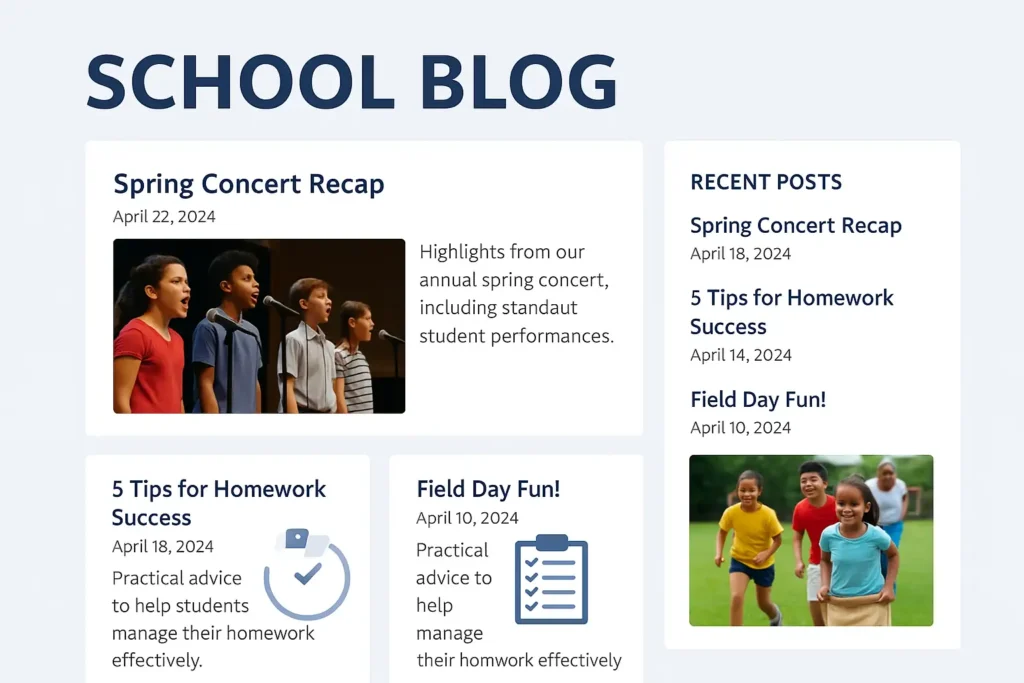
Most school websites are “set and forget.”
Homepage. About. Gallery. Contact. Done.
But here’s the problem — Google doesn’t reward static websites. It rewards content that’s fresh, relevant, and valuable.
If your site hasn’t been updated in months, or worse — never had a blog — you’re signaling to Google that your school isn’t active, evolving, or worth ranking.
Why No Content Means No Visibility
Content is what tells Google:
- What your school is about
- Who it’s for (parents, students, communities)
- What queries your site should rank for
Without regular blog posts or content updates, you:
- Miss long-tail keyword traffic (like “how to choose a school for my child”)
- Lose trust and engagement from parents
- Get outperformed by smaller schools with smarter content plans
Even just 1 blog post a month can boost your visibility dramatically.
How to Fix It – Step-by-Step
Creating content doesn’t mean writing essays. You just need to answer the questions parents are already Googling.
1. Start a Simple School Blog
Suggested categories:
- Parent FAQs – “How to prepare for nursery admission”
- Event Highlights – “Annual Day 2025: What Made It Special”
- Educational Tips – “5 Tips to Help Kids Focus Better at Home”
- School Updates – “Admission Open for 2025-26: Here’s What’s New”
This content helps with SEO and builds trust with your audience.
2. Answer Real Questions
Use tools like:
- AnswerThePublic
- Google’s “People also ask”
- Common parent queries from your front desk
Turn those into blog posts like:
- “Best CBSE Schools in [City] – How to Choose the Right One”
- “How to Apply for School Admission Online in 2025”
3. Include Keywords Naturally
For example:
“Our CBSE school in Patna offers both academic excellence and holistic development…”
This helps Google connect your content to search queries.
4. Update Existing Pages Too
- Add recent awards, events, changes in curriculum, etc.
- Update gallery and testimonials monthly if possible
5. Share the Blog Posts on Other Channels
- WhatsApp parent groups
- School’s Facebook/Instagram page
- Local education forums or Quora answers (with a link)
Pro Tip from a Content Marketing Strategist
Think of your blog as digital proof that your school is alive, modern, and engaging.
Every blog post is a new chance to rank for a new keyword and convert a new parent.
SEO Mistake #7 – Weak On-Page SEO (Titles, Meta, Headings)

You can have a beautiful website and great content — but if Google can’t understand your structure, it won’t rank you.
That’s where on-page SEO comes in — and most school websites either do it wrong or skip it entirely.
This includes:
- Page titles
- Meta descriptions
- Heading tags (H1, H2, H3…)
- URLs
- Keyword placement
It’s the SEO foundation of every page. And skipping it is like writing a book with no title, no chapter names, and no table of contents.
Ready to Take Action? Follow the Proven Blueprint.
Now that you understand why on-page SEO matters, it’s time to implement what works.
👉 Get the Step-by-Step On-Page SEO Guide for School Websites »
Why Poor On-Page SEO Hurts Rankings
Without proper on-page SEO:
- Google can’t easily crawl and categorize your content
- You miss ranking opportunities for keywords you’re already targeting
- Your titles may look bad or confusing in search results
- It reduces CTR (click-through rate), traffic, and trust
Even small fixes can lead to big improvements in visibility.
How to Fix It – Step-by-Step
Here’s a simple checklist to improve your on-page SEO for each page and blog:
1. Use Clear, Keyword-Rich Page Titles
- Example:
❌ Bad: “Home”
✅ Good: “CBSE School in Patna – XYZ Public School | Admissions Open 2025” - Ideal length: 55–60 characters
- Include main keyword near the beginning
2. Write Compelling Meta Descriptions
- This is what shows under your page title in Google
- Make it persuasive but natural
✅ Example: “Looking for a trusted CBSE school in Patna? XYZ Public School offers top-class academics, co-curriculars, and 2025 admission support.” - Keep it under 155–160 characters
3. Use Only One H1 Tag per Page (The Main Heading)
- Make it clear and relevant to the page content
✅ Example: “Welcome to XYZ Public School – CBSE School in Patna”
4. Structure Subheadings with H2 and H3 Tags
- Break content into sections
- Helps Google and users scan your page easily
✅ Example:- H2: “Why Choose Our School?”
- H3: “Academic Programs”
- H3: “Sports and Extracurriculars”
5. Use SEO-Friendly URLs
- Keep it short and readable
✅ Example: /cbse-school-patna instead of /page?id=123
6. Place Keywords Naturally
- In the first 100 words
- In subheadings where relevant
- Avoid stuffing — make it natural and readable
7. Add Alt Text to Images
- Every image should have a short description with relevant keywords
✅ Example: “CBSE school students celebrating Annual Day in Patna”
Pro Tip from a Technical SEO Strategist
On-page SEO is like giving Google a map of your website. Without it, your site is just a lost brochure floating online.
When properly optimized, your site not only ranks better — it also looks cleaner, loads faster, and converts more visitors into parents who take action.
SEO Mistake #8 – Not Tracking SEO Performance (No Analytics)
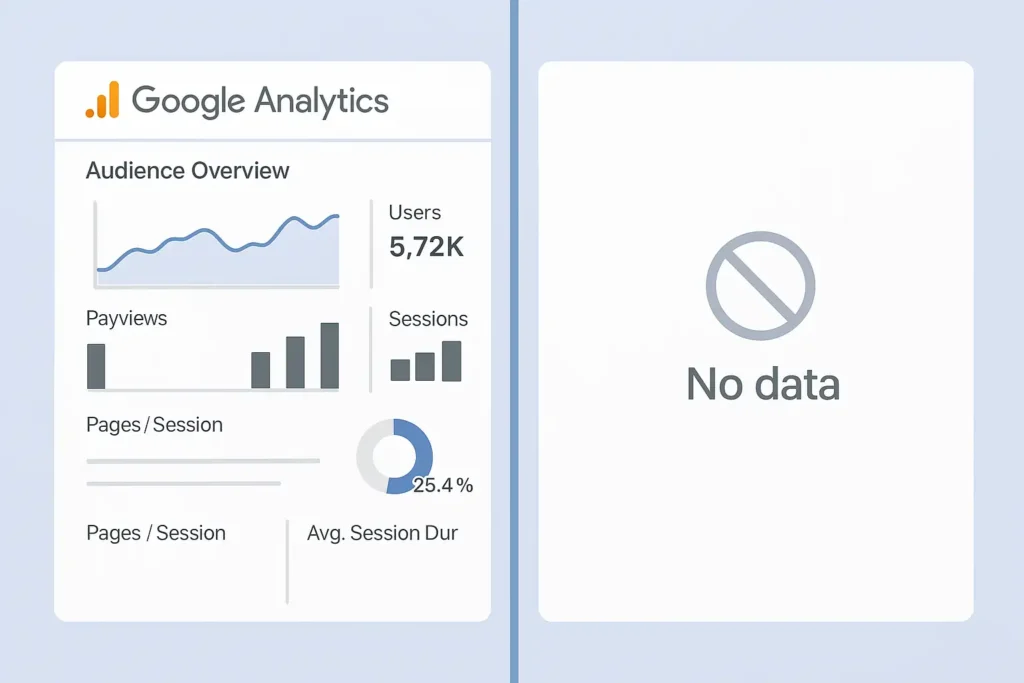
Imagine running a school but never knowing:
- How many students showed up
- Which subjects are most loved
- Where you’re losing attention
That’s what most schools are doing with their websites — they invest in content, design, and SEO, but never track what’s working. Without analytics, you’re flying blind.
Why This Is a Costly Mistake
Without tools like Google Analytics or Google Search Console, schools miss out on:
- Knowing which pages attract the most visitors
- Understanding which keywords are ranking (or not)
- Identifying what’s driving inquiries or form submissions
- Spotting pages that are underperforming or broken
You can’t improve what you don’t measure.
SEO without data is like preparing for an exam with no syllabus and no feedback.
How to Fix It – Step-by-Step
You don’t need a big team or expensive tools to monitor your SEO. You just need two free tools and a monthly habit.
1. Install Google Analytics (GA4)
- Visit analytics.google.com
- Set up a GA4 property and connect it to your school website
- Use a plugin like Site Kit by Google or MonsterInsights on WordPress
Key things to track:
- Number of visitors (daily, monthly)
- Top pages (which blogs or sections people love most)
- Where your traffic comes from (Google, social, direct)
- Device type (mobile/desktop)
2. Set Up Google Search Console (GSC)
- Go to search.google.com/search-console
- Verify your site (via DNS or Google Analytics)
- Submit your sitemap (usually yourdomain.com/sitemap.xml)
Track:
- Keywords you’re ranking for
- Click-through rates (CTR)
- Which pages are gaining or losing rankings
- Indexing issues and mobile usability errors
3. Monitor Once a Month
Make it a habit to:
- Check top 5 pages and top 10 queries
- Note changes and plan content updates
- Identify which blogs or services are performing best
4. Use Ubersuggest or SE Ranking (Optional Tools)
These paid tools can show:
- Competitor keyword gaps
- Backlink profiles
- Keyword difficulty and new ranking opportunities
But you can do 80% of the work with just GA + GSC.
Pro Tip from a Performance Marketer
You don’t need to be a data scientist — just a consistent decision-maker.
Even reviewing analytics once a month can give you insights that unlock big SEO growth.
When schools start measuring their SEO efforts, they make smarter content, target better keywords, and attract more relevant parents.
SEO Mistake #9 – No Backlinks or Local Directory Listings

You’ve probably heard this phrase:
“Content is king — but backlinks are the kingdom.”
That’s because even the best content won’t rank if no one’s linking to it.
Backlinks — links from other websites to yours — are one of Google’s strongest trust signals. They act like digital recommendations.
And most school websites have… none.
Why This Hurts Your SEO Authority
Google treats backlinks like votes of confidence.
If other trusted websites link to your school, Google assumes:
- Your content is credible
- Your institution is reputable
- You deserve to rank higher than others with no links
Want to dive deeper into how schools can build domain authority?
👉 Explore our complete guide to earning high-authority EDU backlinks in 2025.
Without backlinks, you’re seen as a low-authority site — even if your school is doing incredible work.
Also, if you’re not listed on local directories or education portals, you’re missing chances to:
- Improve local SEO
- Drive referral traffic
- Show up in city-based search results
How to Fix It – Step-by-Step
You don’t need PR agencies or big budgets. You just need smart outreach, directory submissions, and community presence.
1. Submit to Trusted Local Directories
- JustDial
- Sulekha
- Yellow Pages
- IndiaEducation.net
- Google Business Profile
- Local school listing websites in your city/state
✅ Make sure your school name, address, and phone number (NAP) are consistent across all platforms.
2. Get Listed in Education Portals or Blogs
- Search “Top CBSE schools in [city]” or “Best schools near [area]”
- Reach out to those websites and ask to be featured or added
- Offer a short write-up about your school with key features and photos
3. Ask for Backlinks from Local Partners
- Collaborate with:
- Coaching centers
- NGOs
- Alumni bloggers
- Educational YouTubers
- Ask them to link back to your site from a blog or resources page
4. Write Guest Articles or Case Studies
- Share tips for parenting, student success, exam prep, etc.
- Submit them to parenting blogs, EdTech startups, or community forums
- Add a backlink to your school’s homepage or blog
5. Use HARO or Qwoted (Advanced)
- These are platforms where journalists request expert input
- Schools can share insights and get quoted — with a backlink
Pro Tip from a Link-Building Strategist
You don’t need hundreds of backlinks — just a few strong, relevant ones can push your rankings significantly.
In fact, a single backlink from a high-authority local education site can outrank dozens of weaker competitors.
SEO Mistake #10 – Poor User Experience and Site Structure
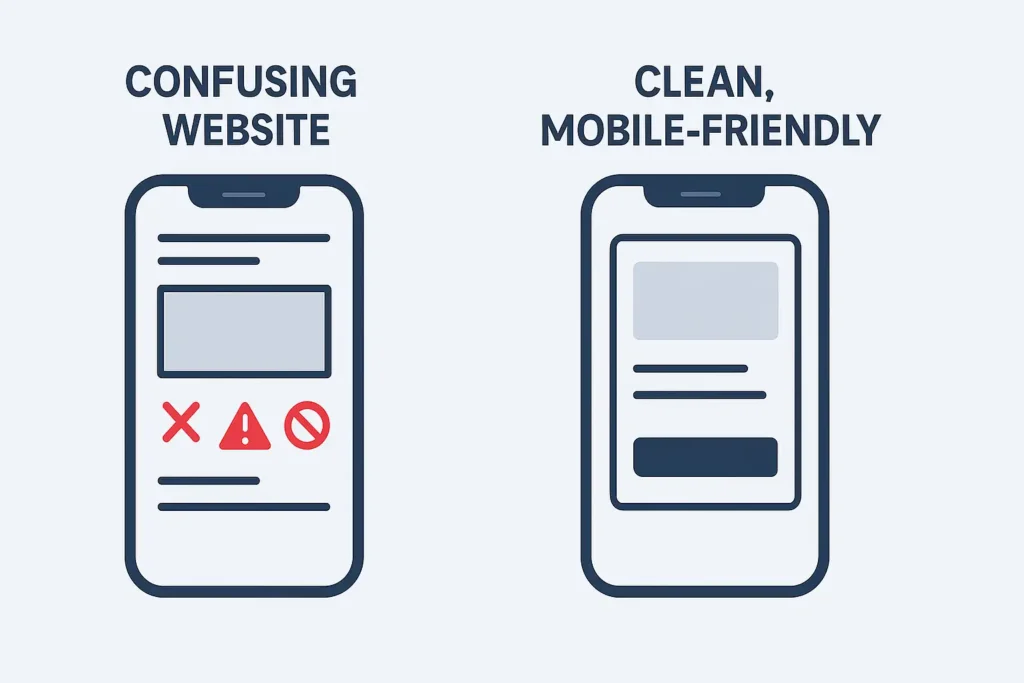
You could have the best content, fastest site, perfect keywords, and even backlinks…
But if parents can’t navigate your website, don’t know where to click, or feel lost — you’ve already lost the battle.
User experience (UX) is now an SEO ranking factor. And yet, most school websites are:
- Cluttered with too much information
- Confusing to navigate
- Lacking clear calls-to-action (CTAs)
- Overloaded with broken links or outdated design
Why Poor UX Hurts Your Rankings (and Admissions)
Google tracks how users behave on your site:
- Do they stay and click?
- Do they bounce immediately?
- Do they explore more pages?
If your site structure makes it hard to find admission forms, results, or school info, people leave — and Google lowers your rankings.
Even worse, frustrated parents don’t come back — and don’t recommend your school to others.
How to Fix It – Step-by-Step
Improving UX is less about flashy design and more about clarity, flow, and function.
1. Simplify the Navigation Menu
- Use a clear structure:
✅ Home | About Us | Admissions | Academics | Blog | Contact - Avoid having 10+ random links in the top menu
- Use dropdowns only when necessary
2. Use Clear Calls-to-Action (CTAs)
- Examples:
- “Download Admission Form”
- “Contact the Principal”
- “View Our Curriculum”
- Place CTAs at the end of every page and blog
3. Make Key Pages Easy to Find
- Put “Admissions,” “Contact,” and “Results” in the top bar and homepage banner
- Use buttons, not just links — especially on mobile
4. Break Content Into Sections With Headings and Icons
- Long paragraphs = fatigue
- Use short blocks, H2/H3 headings, and small icons or images to make content skimmable
5. Fix Broken Links and Update Old Pages
- Use tools like Screaming Frog or Broken Link Checker
- Remove or redirect dead links
- Update outdated info (like old academic years, past events, outdated staff)
6. Test the Site with Real Users
- Ask a parent or student to browse the site and give feedback
- Watch where they get stuck — then fix it
Pro Tip from a UX & SEO Strategist
Don’t design for yourself — design for the parent who’s visiting your site for the first time on mobile, looking for admission info in under 60 seconds.
Great UX reduces bounce rate, increases dwell time, and boosts rankings + conversions — all at once.
With that, you’ve just learned the 10 most common — and most damaging — SEO Mistakes for Schools
You’re now in the top 5% of school owners and administrators who actually understand what it takes to rank in 2025 and beyond.
School SEO Audit Checklist (2025 Edition)
Before you move on, here’s a quick, actionable checklist you can use to audit your school’s SEO performance today.
You don’t need technical skills — just follow each point and mark what’s done ✅ and what needs fixing 🚫.
Use this as a monthly or quarterly check-up to keep your website optimized.
SEO Foundations
- ✅ Claimed and optimized Google Business Profile
- ✅ Website is mobile-friendly and responsive
- ✅ Site loads in under 3 seconds on mobile
- ✅ Keyword strategy is in place (based on real search terms)
- ✅ Targeting local search terms (e.g., “CBSE school in [city]”)
On-Page SEO
- ✅ Unique and keyword-rich page titles
- ✅ Compelling meta descriptions on all pages
- ✅ H1 used only once per page; H2/H3 structured properly
- ✅ Clean URLs (e.g., /admissions-2025/)
- ✅ All images have descriptive alt text
Content Marketing
- ✅ Active blog with at least 1 post per month
- ✅ Blog posts target common parent/student questions
- ✅ Homepage and other key pages updated regularly
- ✅ FAQs section present and SEO-optimized
Performance Tracking
- ✅ Google Analytics (GA4) is installed and tracking visitors
- ✅ Google Search Console is active and indexing site
- ✅ Top-performing pages and keywords reviewed monthly
- ✅ Site errors (404, redirects) checked and fixed
Backlinks & Authority
- ✅ Listed in local directories (JustDial, Sulekha, Yellow Pages)
- ✅ Featured or mentioned in at least 2–5 local education blogs/websites
- ✅ Ongoing effort to build backlinks through collaborations or guest posts
- ✅ Social media profiles link back to the website
User Experience (UX)
- ✅ Simple and clear navigation menu
- ✅ Visible CTAs on all major pages (Admissions, Contact, etc.)
- ✅ No broken links or outdated pages
- ✅ Content is easy to read and mobile-friendly
- ✅ Important pages accessible within 2–3 clicks
Bonus Tip: Keep This Audit Visible
Print this checklist and hang it in your office or digital marketing room.
Doing SEO once isn’t enough — consistency is what brings results.
Mini Case Study – How One School Boosted Admissions with SEO Fixes
Let’s make this real. Here’s a simplified example based on common scenarios we’ve seen while working with schools on their SEO.
School: Springfield Public School, Ranchi (Fictional Example)
The Problem (Before SEO Fixes):
- Website looked great on desktop but was broken on mobile
- Slow load time (6.2 seconds)
- No blog or regular content updates
- Not listed on Google Maps
- Zero backlinks, not found on local directories
- Site not ranking even for “CBSE school in Ranchi”
- Analytics and Search Console not installed
- Contact page had no clear CTA or form
The Impact:
❌ Ranking on page 5 or beyond for all major keywords
❌ Getting less than 50 organic visitors/month
❌ Drop in admission form inquiries during peak season
❌ High bounce rate (over 85%)
❌ Parents calling to ask for basic info instead of finding it online
The SEO Fixes Implemented:
✅ Set up Google Business Profile with updated info and photos
✅ Switched to a mobile-responsive theme
✅ Installed LiteSpeed Cache and compressed all images (WebP)
✅ Created a keyword plan and optimized homepage for “CBSE school in Ranchi”
✅ Added 4 blog posts over 2 months based on parent questions
✅ Submitted site to 7 local directories and 2 education listing portals
✅ Installed Google Analytics and Search Console
✅ Fixed broken links, improved menu structure, added CTA buttons
Results After 90 Days:
📈 Ranked #3 for “CBSE school in Ranchi”
📈 Organic traffic jumped from 50 to 430 visitors/month
📈 Admission inquiries from the website increased by 220%
📈 Bounce rate dropped from 85% to 46%
📈 Featured in “Top 10 Schools in Ranchi” on a local education blog
📈 Received 17 Google reviews with an average rating of 4.6⭐
What This Means for You
This school didn’t hire a big agency.
They didn’t run ads.
They just followed a solid SEO checklist, stayed consistent, and focused on solving problems parents were actually searching for.
If you apply even 50% of what we’ve covered in this guide, your school can get similar — or better — results.
Final Thoughts – Your School’s SEO Journey Starts Now
Here’s the truth: most schools will read articles like this and… do nothing.
They’ll keep running outdated websites.
They’ll ignore what parents are actually searching.
They’ll throw money into ads without fixing the foundation.
But you’re different. You’ve just learned:
- The top 10 SEO Mistakes for Schools
- Why they cost you visibility and trust
- How to fix them using practical, free, and proven strategies
You don’t need to be a tech expert. You just need the right plan — and the will to take the first step.
Ready to Make Your School Visible Online?
Whether you’re a school principal, admin, or marketing coordinator — now is the time to act.
Start by doing a self-audit using the checklist above.
Fix the quick wins first (Google Business Profile, mobile speed, clear CTAs).
Then move toward content and backlinks.
You’ll start seeing the difference — not just in rankings, but in real conversations, form submissions, and admissions.
Want Help? We’ve Got You Covered
At Baniya Insights, we specialize in helping schools:
- Build SEO-optimized websites that actually rank
- Set up local SEO, Google Business, and analytics
- Create blogs and content that parents are already searching for
- Grow organic visibility without relying on paid ads
➡ Need a free audit or personalized SEO strategy for your school?
[Request a Free Proposal] — we’re ready to help.
You’ve invested in your students. Now it’s time to invest in your digital visibility.
Because in 2025, the schools that show up online are the ones that get chosen.

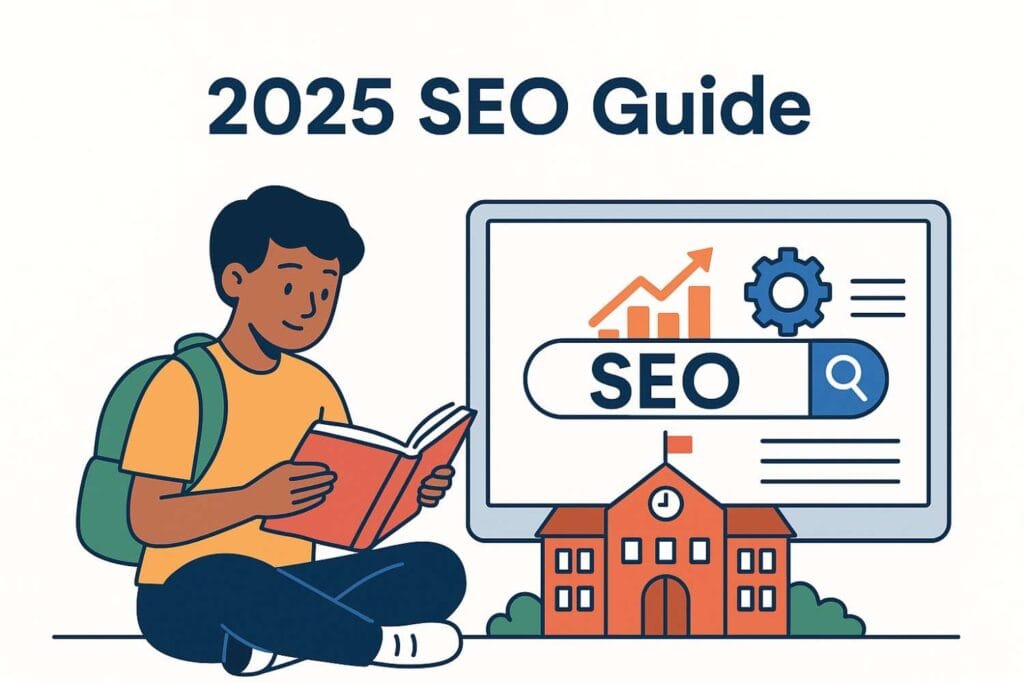

Pingback: Answer Engine Optimization (AEO) for Schools: Your Secret Edge in AI Search 2025